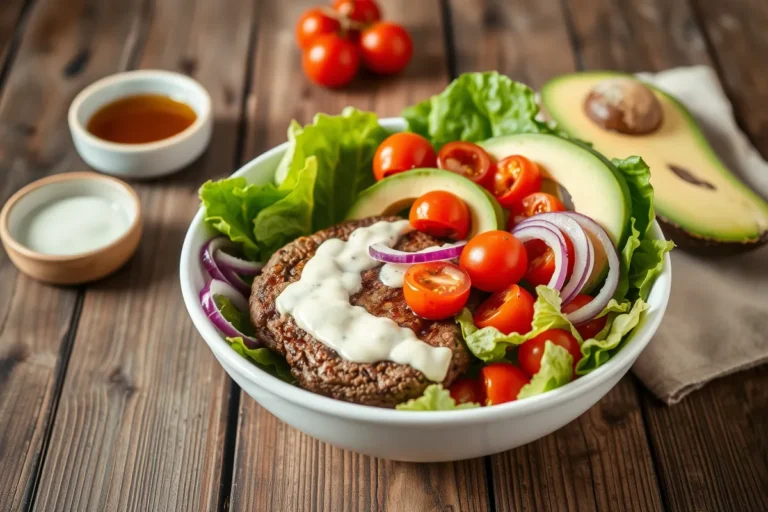Introduction and Essentials
What is a Burger Bowl?
A burger bowl is a deconstructed burger served in a bowl instead of between a bun. This popular dish combines all the elements of a traditional burger—protein, toppings, and sauces—but delivers them in a healthier, more customizable format. Whether you’re looking for a low-carb alternative or simply a creative spin on a classic favorite, the Burger Bowl Recipe fits the bill.
Origins and Popularity of Burger Bowls
The concept of a Burger Bowl Recipeemerged from the broader movement toward healthy eating and carb-conscious lifestyles. Inspired by diets like keto, paleo, and low-carb, it’s a way to enjoy the classic burger without bread. The trend gained traction in restaurants and home kitchens alike, especially among those seeking versatility and health benefits.
Why Choose a Burger Bowl Recipe Over a Traditional Burger?
There are many reasons to swap your bun for a bowl:
- Customizable for all diets: Keto, vegan, and gluten-free options abound.
- Portion control: Easier to manage than a towering burger.
- Enhanced flavors: Ingredients stay fresher and crisper.
Benefits of a Burger Bowl
Health Benefits
The burger bowl is not just a tasty alternative; it’s also a healthier one. Here’s why:
- Lower in carbs: Ideal for weight loss or blood sugar control.
- Nutrient-dense: Packed with fresh vegetables and lean proteins.
- Supports dietary goals: Easily adjusted for specific macros or calorie targets.
Versatility of Ingredients
The flexibility of burger bowls is unmatched:
- Swap ground beef for chicken, turkey, or plant-based proteins.
- Include vegetables of your choice, from crisp greens to roasted squash.
- Experiment with dressings like classic ranch or spicy aioli.
Essential Ingredients for a Classic Burger Bowl Recipe
Protein Options
The protein is the heart of your bowl:
- Beef: Choose lean ground beef for a classic burger flavor.
- Chicken or turkey: A lighter option with less fat.
- Plant-based proteins: Try tofu, tempeh, or black bean patties for a vegan twist.
Vegetables and Toppings
Build a colorful, nutrient-packed base:
- Fresh greens like romaine or spinach.
- Grilled or raw vegetables such as zucchini, peppers, or cucumber.
- Fun toppings like avocado slices, pickles, or red onion.
Sauces and Dressings
No burger bowl is complete without a drizzle of flavor:
- Classic choices: Ranch, blue cheese, or ketchup-mustard combos.
- Creative options: Spicy sriracha mayo or tangy vinaigrette.
Necessary Tools for Making a Burger Bowl
Kitchen Equipment and Tools
To whip up your burger bowl effortlessly, make sure to have:
- A mixing bowl for tossing ingredients.
- A non-stick skillet or grill pan for cooking proteins.
- A sharp knife for chopping vegetables.
Storage and Meal Prep Tips
- Use airtight containers to store prepped ingredients.
- Chop veggies in advance to save time.
- Store dressings separately to avoid sogginess.
Customizing Your Burger Bowl
Adapting to Dietary Needs
No matter your diet, there’s a burger bowl for you:
- Keto: Focus on high-fat ingredients like cheese and avocado.
- Vegan: Opt for lentil patties and creamy cashew dressing.
- Gluten-free: Skip grains or use quinoa as a base.
Unique Flavors and Add-Ons
Elevate your bowl with creative choices:
- Add a fried egg for richness.
- Sprinkle with seeds or nuts for crunch.
- Experiment with international spices like za’atar or curry powder.
Step-by-Step Instructions for Crafting Your Burger Bowl Recipe
Preparing the Protein
Ground Beef or Alternatives
The protein sets the stage for the flavors of your burger bowl:
- Use 80/20 ground beef for a juicy base or choose leaner cuts for fewer calories.
- Alternatives like ground chicken, turkey, or tofu crumbles work well too.
Marinating and Cooking Techniques
To infuse flavor:
- Marinate proteins with simple seasonings like garlic, onion powder, and smoked paprika.
- For grilling, preheat your pan or grill to medium-high heat.
- Cook ground meats until they’re no longer pink, ensuring an internal temperature of 160°F (71°C).
Selecting the Base for Your Bowl
Leafy Greens
Your base adds freshness and balance:
- Romaine lettuce provides crunch.
- Spinach or kale adds a boost of nutrients.
- Mix different greens for a varied texture.
Grains and Alternatives
If you prefer a heartier bowl:
- Quinoa: High-protein and gluten-free.
- Brown rice: Adds a nutty flavor and chewy texture.
- Cauliflower rice: A low-carb alternative with a mild flavor.
Chopping and Prepping Vegetables
Fresh and Crunchy Vegetables
For a refreshing element:
- Dice cucumber and tomatoes into bite-sized pieces.
- Slice red onions thinly for a tangy bite.
- Add shredded carrots or purple cabbage for color and crunch.
Roasted and Grilled Options
Enhance flavors with roasted vegetables:
- Toss zucchini, mushrooms, or bell peppers in olive oil, salt, and pepper.
- Roast at 400°F (200°C) for 15–20 minutes or grill for smoky charred edges.
Creating the Perfect Dressing
Homemade Burger Bowl Recipe Sauces
Elevate your bowl with DIY dressings:
- Classic ranch: Blend mayonnaise, buttermilk, garlic, and herbs.
- Spicy aioli: Mix mayonnaise with sriracha and lime juice.
- Vinaigrette: Whisk olive oil, balsamic vinegar, Dijon mustard, and honey.
Balancing Flavors in Dressings
To achieve a balanced dressing:
- Combine acidic elements like vinegar or citrus with fats like olive oil.
- Add a touch of sweetness with honey or maple syrup.
Assembling the Burger Bowl
Layering Techniques for Best Presentation
- Start with your base (greens or grains).
- Add protein as the focal point in the center.
- Arrange vegetables and toppings around the protein for visual appeal.
Tips for Even Flavor Distribution
- Toss greens lightly with a small amount of dressing beforehand.
- Use a spoon to drizzle dressing evenly over the top layer.
Adjusting the Recipe for Serving Sizes
Single-Serve vs. Family-Style
- Single-serve bowls: Prepare individual portions in smaller containers.
- Family-style platters: Lay out components buffet-style for easy customization.
Portion Control Tips
- Measure proteins and toppings to avoid overloading.
- Aim for 1 cup of greens, 4–6 oz of protein, and ½ cup of vegetables per serving.
Cooking Times and Troubleshooting
Avoiding Overcooking Ingredients
- Cook proteins just until they’re done to maintain juiciness.
- Roast vegetables until tender but not mushy.
Quick Fixes for Common Issues
Soggy vegetables? Toss them back in the oven for a few minutes to crisp.
Dry protein? Add a drizzle of olive oil or extra dressing.
Variations and Enhancements for Your Burger Bowl Recipe
Burger Bowl Variations from Around the World
Mexican-Inspired Burger Bowl
Spice up your bowl with bold Mexican flavors:
- Protein: Use taco-seasoned ground beef, chicken, or plant-based crumbles.
- Vegetables: Include black beans, roasted corn, and diced tomatoes.
- Toppings: Add sliced avocado, pickled jalapeños, shredded cheese, and fresh cilantro.
- Dressing: Drizzle with chipotle lime crema or your favorite salsa.
To take it up a notch, add a crunchy element like tortilla strips or crushed nachos. The combination of vibrant flavors and textures makes this bowl a fiesta in your mouth.
Asian Fusion Burger Bowl
For a light yet flavorful twist:
- Protein: Marinate tofu, shrimp, or beef in teriyaki sauce or soy-ginger glaze.
- Vegetables: Toss in shredded carrots, thinly sliced cucumber, and edamame.
- Toppings: Garnish with sesame seeds, chopped scallions, and crushed peanuts.
- Dressing: A spicy peanut sauce or soy-based vinaigrette brings it all together.
Serve on a bed of jasmine rice or mixed greens for a satisfying meal that balances sweet, savory, and spicy.
Mediterranean Burger Bowl
Transport your taste buds to the Mediterranean:
- Protein: Use lamb patties, chicken shawarma, or falafel.
- Vegetables: Add cucumber, cherry tomatoes, red onion, and Kalamata olives.
- Toppings: Sprinkle with crumbled feta cheese and fresh parsley.
- Dressing: Use a lemon-tahini sauce or tzatziki.
Pair this with warm pita bread on the side for a full Mediterranean experience.
Adding a Twist to the Classic Recipe
Using Exotic Proteins
Switching up your protein can transform your burger bowl into a gourmet dish:
- Bison: Rich and slightly sweet, it’s a leaner alternative to beef.
- Duck: Perfect for a richer, more indulgent flavor.
- Seafood: Shrimp, salmon, or crab cakes bring a fresh twist.
Experimenting with Unique Vegetables
Break away from the norm with less common veggies:
- Grilled eggplant or roasted Brussels sprouts add depth.
- Artichoke hearts and roasted red peppers offer a Mediterranean flair.
- Spiralized zucchini noodles can replace traditional greens or grains for a low-carb base.
Incorporating these ingredients adds not only variety but also additional nutrients and textures to your bowl.
Pairing Burger Bowls with Sides
Light Appetizers
Complement your bowl with these quick sides:
- Sweet potato fries: A healthier alternative to traditional fries.
- Stuffed mushrooms: Fill them with garlic, cheese, or herbs for a bite-sized treat.
- Cucumber salad: A refreshing, palate-cleansing option.
Beverage Pairings
Pair your burger bowl with a drink to enhance the meal:
- Craft beer: A pale ale or IPA pairs well with savory flavors.
- Iced tea: Sweetened or unsweetened tea complements lighter bowls.
- Wine: A cabernet sauvignon or pinot noir complements beef or lamb, while a sauvignon blanc works well with seafood.
Storing and Reheating Leftovers
Best Practices for Freshness
To keep your burger bowl components fresh:
- Store proteins, greens, and dressings in separate airtight containers.
- Keep greens crisp by wrapping them in a paper towel before sealing.
Maximizing Shelf Life
- Proteins: Store cooked meat for 3–4 days in the fridge, or freeze for up to 3 months.
- Vegetables: Blanch hardy vegetables like broccoli before storing to retain texture.
- Dressings: Keep in the fridge for up to 1 week in a sealed jar.
When reheating proteins, add a splash of water or broth to maintain moisture.
Advanced Techniques for Presentation
Garnishing for a Gourmet Look
Take your burger bowl presentation to the next level:
- Use colorful garnishes like pickled red onions, microgreens, or edible flowers.
- Sprinkle spices like paprika, smoked sea salt, or black sesame seeds for contrast.
- Arrange toppings symmetrically or in clusters to make the bowl visually appealing.
Using Edible Bowls as an Alternative
For a fun twist, serve your burger bowl in an edible container:
- Roasted squash: Acorn squash or spaghetti squash can hold your bowl ingredients while adding a hint of sweetness.
- Bell peppers: Hollowed-out peppers make a crunchy and colorful option.
This approach not only adds a creative element but also reduces cleanup time.
More FAQs
- Can I make burger bowls in advance?
Yes! Store components separately and assemble just before serving. - What are some vegan protein options?
Try black bean patties, tempeh, or marinated tofu. - How can I make my burger bowl kid-friendly?
Use mild flavors and simple toppings like cheddar cheese and ketchup. - Can I use leftover burger patties?
Absolutely. Crumble them or slice them into smaller pieces for your bowl. - What’s the best grain for a gluten-free base?
Quinoa is an excellent choice because it’s gluten-free and nutrient-dense. - How do I make my bowl dairy-free?
Use vegan cheeses and substitute cashew cream for traditional dressings. - What’s the most versatile dressing?
A honey mustard vinaigrette pairs well with a variety of proteins and vegetables. - Are burger bowls good for meal prep?
Yes, they’re great for prepping in bulk and customizing later. - Can I serve burger bowls cold?
Definitely! They taste delicious as a chilled salad. - What toppings add crunch?
Crispy onions, nuts, seeds, or crumbled tortilla chips are perfect for texture.

